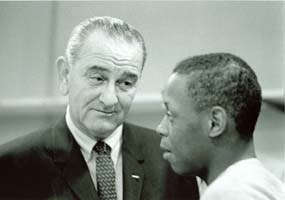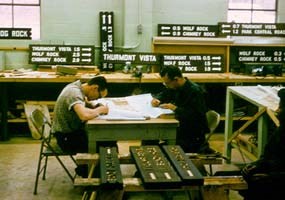

A rising level of unemployment and social unrest developed in the early 1960's as the nation's economy experienced a downturn. President Lyndon B. Johnson proposed the Job Corps as a partial solution to this problem and his War on Poverty. This program, patterned after the Civilian Conservation Corps, recruited economically deprived young men between the ages of 16 and 21, most with a ninth grade education level. The goal was to teach work habits and attitude along with vocational skills. Investigation of Catoctin as a potential Job Corps site began in May 1964, six months before passage of the Economic Recovery Act. A site within Camp Round Meadow was chosen for the site of the nations's first Job Corps Center. Eighty-five young men arrived at Camp Round Meadow on January 15, 1965. The early months of 1965 were spent completing the camp, building sidewalks, underpinning trailers, and landscaping. In the winter, corpsmen spent half their day at work and half their day in classrooms. Full days of work and education were altered in the summer. First year projects included trail repair, construction of 150 picnic tables and 2 fire circles for the organized camps. 
NPS Photo As the corpsmen became more skilled, staff members developed more complex projects. Corpsmen developed and scheduled a production line that produced 225 signs for Catoctin Mountain Park, Greenbelt Park, Antietam National Battlefield, and Cunningham Falls State Park. Today, a form of the original Job Corps still exists. The National Park Service operates a Job Corps Center at Harpers Ferry, West Virginia. Young men and women are taught vocational skills along with teamwork and work ethics, and leadership. Their newly developing job skills are often utilized at area National Parks on new construction and other projects, providing meaningful opportunities in the workforce in addition to the classroom experiences. |
Last updated: April 10, 2015

